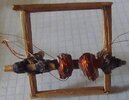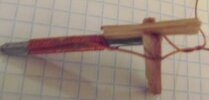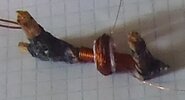I was on a Russian forum and people there perceive the idea as spam.
I want to make a reciprocating engine. This engine has many advantages - a minimum of parts, cheap and because there is no gearbox has direct control of the wing.
I need to calculate the engine before producing it.
The "motor" I want to make is a speaker with an electromagnet instead of a permanent magnet. I think I need to find the speaker calculation information. But I couldn't find or searched badly.
I need a 100 W motor with a frequency of up to 8 Hz.
The moment of force (newton) is not very important, because with the help of a lever I can achieve any force.
Additional requirements: weight of 2 motors up to 500 grams.
--------------------
I made a bad model of what I want from wood in half an hour (I can't simulate on a computer)
Sorry



~ 30 turns of 0.5 mm wire are wound on an iron rod (2)
Wound one coil with 0.1mm wire, 100 turns (3)
Dual coil construction on frame (1)
The model does not work when current is applied (by design, the coils should have moved)
I hope the idea is clear. I wound it with a thin wire only because it was difficult to wind it with a thick one (0.5 mm). All this must be powered by a voltage of 3 Volts (stab.), And the engine will be made using plastic, epoxy, electrical steel and will resemble a factory
I ask you to help me create or suggest where you can buy such an existing one (or an ornithopter with it), I need a noiseless camera for photography (a quadcopter is not suitable)
I want to make a reciprocating engine. This engine has many advantages - a minimum of parts, cheap and because there is no gearbox has direct control of the wing.
I need to calculate the engine before producing it.
The "motor" I want to make is a speaker with an electromagnet instead of a permanent magnet. I think I need to find the speaker calculation information. But I couldn't find or searched badly.
I need a 100 W motor with a frequency of up to 8 Hz.
The moment of force (newton) is not very important, because with the help of a lever I can achieve any force.
Additional requirements: weight of 2 motors up to 500 grams.
--------------------
I made a bad model of what I want from wood in half an hour (I can't simulate on a computer)
Sorry



~ 30 turns of 0.5 mm wire are wound on an iron rod (2)
Wound one coil with 0.1mm wire, 100 turns (3)
Dual coil construction on frame (1)
The model does not work when current is applied (by design, the coils should have moved)
I hope the idea is clear. I wound it with a thin wire only because it was difficult to wind it with a thick one (0.5 mm). All this must be powered by a voltage of 3 Volts (stab.), And the engine will be made using plastic, epoxy, electrical steel and will resemble a factory
I ask you to help me create or suggest where you can buy such an existing one (or an ornithopter with it), I need a noiseless camera for photography (a quadcopter is not suitable)



